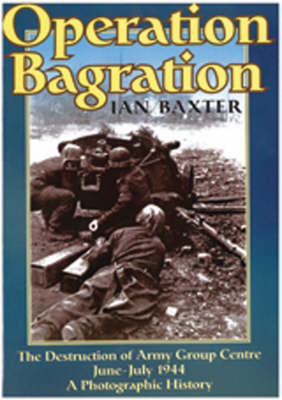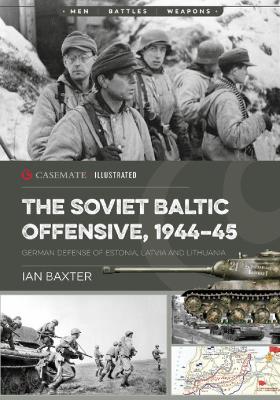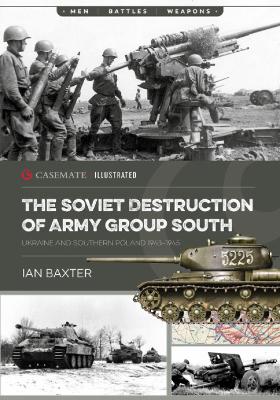Casemate Illustrated
4 total works
In the summer of 1943, the German launched Operation Zitadelle (Citadel), aimed at cutting off a large number of Soviet forces in the Kursk salient. This offensive resulted in the battle of Kursk, the largest tank battle of World War II.
Kursk quickly became a fierce contest of attrition, as Wehrmacht and elite Waffen-SS Panzer-Divisions with their powerful Tiger and Panther tanks unsuccessfully tried to hammer their way through the intricate lines of strong Soviet defensive positions. What followed was unabated fighting for two weeks as German units were slowly and systematically ground down in a series of brutal armored battles.
During this ferocious fighting the Red Army savagely contested every foot of ground, finally ending German invincibility forever. For the first time in its short history, the blitzkrieg concept had failed. The reverberations caused by the defeat at Kursk were immense, and never again did the German war machine go on the offensive in the East. Stiff defensive action was now the stratagem placed upon the dwindling Panzerwaffe right to the gates of Berlin.
With comprehensive captions and text, Kursk tells the story of this dramatic battle using rare and unpublished photographs, maps, and highly detailed artist profiles. The book reveals the events leading up to the battle in the first half of 1943, and the build up of forces by both sides before their climatic showdown at Kursk.
Kursk quickly became a fierce contest of attrition, as Wehrmacht and elite Waffen-SS Panzer-Divisions with their powerful Tiger and Panther tanks unsuccessfully tried to hammer their way through the intricate lines of strong Soviet defensive positions. What followed was unabated fighting for two weeks as German units were slowly and systematically ground down in a series of brutal armored battles.
During this ferocious fighting the Red Army savagely contested every foot of ground, finally ending German invincibility forever. For the first time in its short history, the blitzkrieg concept had failed. The reverberations caused by the defeat at Kursk were immense, and never again did the German war machine go on the offensive in the East. Stiff defensive action was now the stratagem placed upon the dwindling Panzerwaffe right to the gates of Berlin.
With comprehensive captions and text, Kursk tells the story of this dramatic battle using rare and unpublished photographs, maps, and highly detailed artist profiles. The book reveals the events leading up to the battle in the first half of 1943, and the build up of forces by both sides before their climatic showdown at Kursk.
Operation Bagration - the Russian codename for the 1944 summer offensive, which led to the complete annihilation of Army Group Centre - was without doubt the most devastating defeat ever experienced by the German Army during the Second World War. Yet this mammoth offensive has for years been completely overshadowed by the Normandy campaign, which was unleashed just three weeks prior to Bagration along the shores of northern France. The battle which the German forces of Army Group Centre endured on the Eastern Front that fateful summer was more catastrophic than that experienced on the Western Front, but the English-speaking world remains largely ignorant of its details. This book reveals the lesser-known battle in the East and demonstrates the gallantry and self-sacrifice of the German forces against overwhelming odds.
Drawing on rare and previously unpublished photographs accompanied by in-depth captions the book vividly describes how the German forces of Army Group Centre endured a massive Russian offensive three years to the day after Germany`s 1941 invasion of the Soviet Union. Fighting over many of the same battlefields, it reveals how scores of German troops were urged on by their Fuhrer to defend their positions to the death in a desperate attempt to prevent the mighty Red Army forces from recapturing Byelorussia, the last bastion of defence for the Germans before Poland. The Bagration offensive was a bloodthirsty battle of attrition which resulted in a catastrophe of unbelievable proportions. Throughout the book the author provides an absorbing analysis of this traumatic battle and shows how German soldiers continued to fight to the bitter end amidst the constant hammer blows of ground and aerial bombardment, and endless armoured and infantry attacks. Although many German units continued to wage a grim and bitter defence the Red Army swamped the already overstretched front lines. The Soviets punched massive holes in the disintegrating defences almost everywhere, letting through a seemingly-unstoppable flood, pushing apart and encircling many precious German Panzer and infantry divisions. In the end Bagration cost the Wehrmacht more men and material than the catastrophe at Stalingrad sixteen months earlier. The shattering defeat of Army Group Centre resulted in the loss of over 300,000 men and witnessed Soviet forces pushing exhausted German remnants out of Russia and through Poland to the gates of Warsaw.
Drawing on rare and previously unpublished photographs accompanied by in-depth captions the book vividly describes how the German forces of Army Group Centre endured a massive Russian offensive three years to the day after Germany`s 1941 invasion of the Soviet Union. Fighting over many of the same battlefields, it reveals how scores of German troops were urged on by their Fuhrer to defend their positions to the death in a desperate attempt to prevent the mighty Red Army forces from recapturing Byelorussia, the last bastion of defence for the Germans before Poland. The Bagration offensive was a bloodthirsty battle of attrition which resulted in a catastrophe of unbelievable proportions. Throughout the book the author provides an absorbing analysis of this traumatic battle and shows how German soldiers continued to fight to the bitter end amidst the constant hammer blows of ground and aerial bombardment, and endless armoured and infantry attacks. Although many German units continued to wage a grim and bitter defence the Red Army swamped the already overstretched front lines. The Soviets punched massive holes in the disintegrating defences almost everywhere, letting through a seemingly-unstoppable flood, pushing apart and encircling many precious German Panzer and infantry divisions. In the end Bagration cost the Wehrmacht more men and material than the catastrophe at Stalingrad sixteen months earlier. The shattering defeat of Army Group Centre resulted in the loss of over 300,000 men and witnessed Soviet forces pushing exhausted German remnants out of Russia and through Poland to the gates of Warsaw.
This is a compelling account of the German defense of the Baltic States of Estonia, Latvia and Lithuania. Against overwhelming Soviet forces the book shows how the German Army Group North was driven across the Baltics from Leningrad and fought a number isolated battles including the defense of Narva, Memel and the Kurland pocket.
The book outlines in dramatic detail how Hitler forbade his troops to withdraw, ordering them to follow his Halt Order Decree and fight to the death. However, exhausted and demoralized by continuous Soviet assaults, Army Group North became cut-off and isolated, fighting fanatically to hold the capital cities of Tallin, Vilnius and Riga. What followed were German forces fighting to the death in the last few small pockets of land surrounding three ports: Libau in Kurland, Pillau in East Prussia and Danzig at the mouth of the River Vistula. In the Kurland, German divisions became surrounded and fought a vicious defense until May 1945.
Drawing on a host of rare and unpublished photographs accompanied by in-depth captions and text, the book provides an absorbing read of the Red Army's conquering of the Baltics.
The book outlines in dramatic detail how Hitler forbade his troops to withdraw, ordering them to follow his Halt Order Decree and fight to the death. However, exhausted and demoralized by continuous Soviet assaults, Army Group North became cut-off and isolated, fighting fanatically to hold the capital cities of Tallin, Vilnius and Riga. What followed were German forces fighting to the death in the last few small pockets of land surrounding three ports: Libau in Kurland, Pillau in East Prussia and Danzig at the mouth of the River Vistula. In the Kurland, German divisions became surrounded and fought a vicious defense until May 1945.
Drawing on a host of rare and unpublished photographs accompanied by in-depth captions and text, the book provides an absorbing read of the Red Army's conquering of the Baltics.
Following the destruction of Sixth Army at Stalingrad in February 1943, Army Group South slowly withdrew westwards, using the Dnieper as a fortified position. In late 1943, the Soviet 1st, 2nd, 3rd, and 4th Ukrainian Front launched a strategic offensive against the German Army Group South A – one of the largest operations of the war. In May 1944, Red Army troops defeated Army Group South and Army Group A on the Dnieper. Many thousands of German troops evacuated across the Black Sea. In July, troops of the 1st Ukrainian Front launched an operation into the Crimea. The offensive coincided with other Red Army operations further north, including the Lublin-Brest Offensive – part of Operation Bagration. Slowly and inexorably, the powerful Russian attacks forced the tattered German army group to retreat hundreds of miles west, into Eastern Poland and Romania. Here German forces defended their positions and built defences in Hungary and Austria to try and slow down the overwhelming might of the Red Army. There, the Germans would fight a series of desperate battles until the remnants surrendered in early May 1945.
Drawing on rare and previously unpublished images accompanied by detailed captions and text, the book gives a fascinating analysis of the destruction of Army Group South in southern Russia between 1944 and 1945.
Drawing on rare and previously unpublished images accompanied by detailed captions and text, the book gives a fascinating analysis of the destruction of Army Group South in southern Russia between 1944 and 1945.



